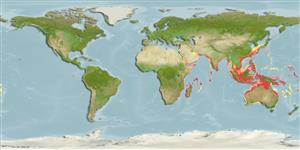Environment: milieu / climate zone / depth range / distribution range
Ökologie
seewasser demersal; standorttreu; tiefenbereich ? - 132 m (Ref. 75154). Tropical
Indo-West Pacific: southern India and Sri Lanka to Malaysia, Gulf of Thailand, Hong Kong, Taiwan, Indonesia, Philippines, the Arafura Sea (Ref. 9819), Northwest Shelf of Australia to Coral Sea.
Size / Gewicht / Alter
Maturity: Lm ? range ? - ? cm
Max length : 26.0 cm TL Männchen/unbestimmt; (Ref. 9790); common length : 18.0 cm TL Männchen/unbestimmt; (Ref. 9790)
Rückenflossenstacheln (insgesamt): 9; Rückenflossenweichstrahlen (insgesamt): 11-12; Afterflossenstacheln 0; Afterflossenweichstrahlen: 12 - 13. Preopercular spines 3, upper long, bayonet-like, reaching to or past opercular margin. Anterior 13-33 lateral line scales bearing a small spine or ridge. Iris lappet bilobed in adults, crenate in juveniles. Finger-like interopercular flap present. Total gill rakers on first arch 7-9, usually 8.
Life cycle and mating behavior
Geschlechtsreife | Fortpflanzung | Ablaichen | Eier | Fecundity | Larven
Kailola, P.J., 1987. The fishes of Papua New Guinea: a revised and annotated checklist. Vol. II Scorpaenidae to Callionymidae. Research Bulletin No. 41, Research Section, Dept. of Fisheries and Marine Resources, Papua New Guinea. (Ref. 6192)
IUCN Rote Liste Status (Ref. 130435)
Bedrohung für Menschen
Harmless
Nutzung durch Menschen
Fischereien: weniger kommerziell
Mehr Information
NamenSynonymeMetabolismusRäuberÖkotoxikologieFortpflanzungGeschlechtsreifeAblaichenSpawning aggregationFecundityEierEientwicklung
ReferenzenAquakulturAquakultur ProfilZuchtlinienGenetikElectrophoresesVererbbarkeitKrankheitenVerarbeitungNutrientsMass conversion
PartnerBilderStamps, Coins Misc.LauteCiguateraGeschwindigkeitSchwimmstilKiemenoberflächeOtolithsGehirngrößeSehfähigkeit
Tools
Zusatzinformationen
Download XML
Internet Quellen
Estimates based on models
Preferred temperature (Ref.
123201): 23.6 - 28.6, mean 27.4 °C (based on 911 cells).
Phylogenetic diversity index (Ref.
82804): PD
50 = 0.6250 [Uniqueness, from 0.5 = low to 2.0 = high].
Bayesian length-weight: a=0.00525 (0.00246 - 0.01120), b=3.04 (2.85 - 3.23), in cm total length, based on LWR estimates for this (Sub)family-body shape (Ref.
93245).
Trophic level (Ref.
69278): 3.7 ±0.6 se; based on size and trophs of closest relatives
Widerstandsfähigkeit (Ref.
120179): hoch, Verdopplung der Population dauert weniger als 15 Monate. (Preliminary K or Fecundity.).
Fishing Vulnerability (Ref.
59153): Low vulnerability (16 of 100).
